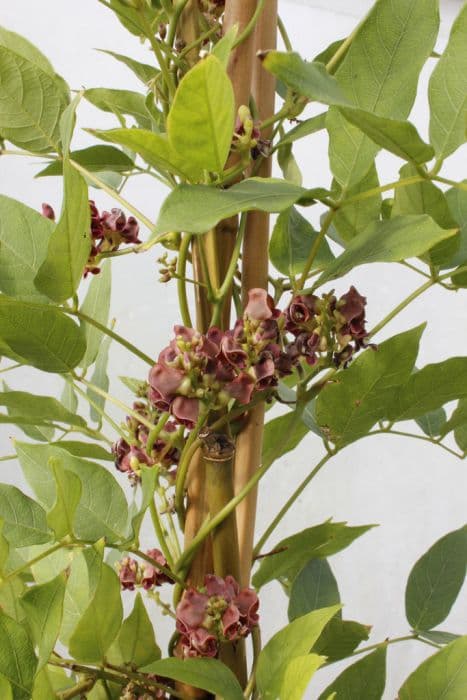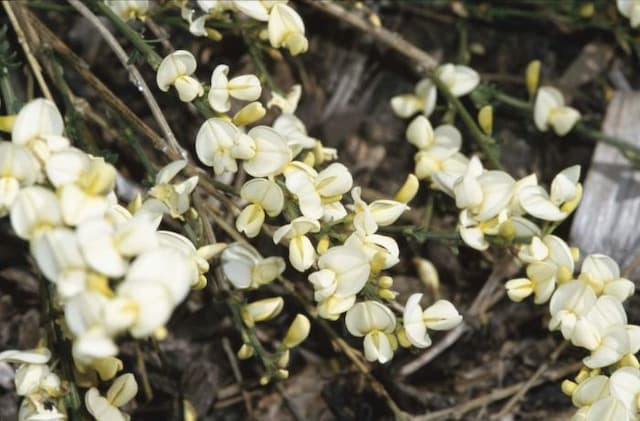Red Rum Lupine Lupinus 'Red Rum' (PBR)

ABOUT
Lupinus 'Red Rum', commonly known as Red Rum Lupine, is a striking ornamental plant renowned for its beautiful flower spikes. The plant sports a bushy clump of palmate leaves which are intricately divided into narrow, finger-like leaflets. These leaves are a deep green color that serves as a lush backdrop for the vibrant blooms. The most captivating aspect of the Red Rum Lupine is its stunning flower spikes, which carry a dense cluster of pea-like flowers. These blossoms boast an intense red hue with subtle orange undertones, giving them a warm, fiery appearance. The flowers are closely packed on the spike, opening sequentially from the bottom to the top, creating an extended display of color throughout the blooming period. This Lupine variety is also quite favored for the contribution it makes to the garden's aesthetic, due to its well-structured foliage and striking floral show. The contrast between the deeply-colored flowers and the dark foliage creates a dramatic display that can catch any onlooker's eye. These qualities make the Red Rum Lupine a popular choice for garden borders, beds, and as a statement piece when planted in drifts or clumps.
About this plant
 Names
NamesFamily
Fabaceae.
Synonyms
Red Rum Lupine, Border Lupin 'Red Rum'.
Common names
Lupinus 'Red Rum' (PBR)
 Toxicity
ToxicityTo humans
Lupine, including the variety known as 'Red Rum', contains toxic alkaloids that can be harmful if ingested. When parts of the plant are consumed by humans, symptoms of lupine poisoning can include dizziness, confusion, rapid heartbeat, difficulty breathing, convulsions, and potentially coma. Severe poisoning can be fatal and medical attention should be sought immediately if ingestion occurs.
To pets
Lupine is also toxic to pets such as dogs and cats. Ingesting this plant can lead to symptoms including lethargy, vomiting, hypotension (decreased blood pressure), agitation, and even respiratory distress. More severe cases can result in neuromuscular paralysis or convulsions. Immediate veterinary care is critical if a pet has consumed any part of a lupine plant.
 Characteristics
CharacteristicsLife cycle
Perennials
Foliage type
Deciduous
Color of leaves
Green
Flower color
Red
Height
3 feet (0.91 meters)
Spread
2 feet (0.61 meters)
Plant type
Herb
Hardiness zones
4
Native area
North America
Benefits
 General Benefits
General Benefits- Vibrant Color: Produces striking red flowers that add a vibrant splash of color to gardens and landscapes.
- Attracts Pollinators: The flowers are attractive to bees and other pollinators, supporting local ecosystems.
- Nitrogen Fixation: Like other members of the lupine family, it improves soil fertility by fixing atmospheric nitrogen.
- Easy to Grow: Known for its hardiness and ability to grow in a variety of soil conditions, making it suitable for many gardeners.
- Landscape Design: Ideal for cottage gardens, borders, and as a focal point due to its height and color.
- Fast Growth: Grows relatively quickly, allowing gardeners to establish a display in a shorter period.
- Drought Resistance: Once established, it is somewhat drought-tolerant, requiring less watering than some other garden plants.
- Deer Resistance: Often avoided by deer, which helps to prevent damage to the plant and maintain its aesthetic appeal.
 Medical Properties
Medical PropertiesThis plant is not used for medical purposes.
 Air-purifying Qualities
Air-purifying QualitiesThis plant is not specifically known for air purifying qualities.
 Other Uses
Other Uses- Lupine seeds, such as those from 'Red Rum', can be used as a protein-rich grain alternative after proper preparation to remove alkaloids.
- Lupine fibers can be utilized in textile production, offering a sustainable material similar to wool or cotton.
- 'Red Rum' lupine's stalks can be processed into paper products, serving as a non-traditional fiber source in papermaking.
- The plant has potential use in phytoremediation, helping to restore nitrogen in degraded soils and improving soil health.
- Lupine roots are known for their nitrogen-fixing capabilities, which can be harnessed to increase the fertility of agricultural lands naturally.
- The flowering spikes of 'Red Rum' lupine can be used in floral arrangements and crafts for their striking red color.
- Lupine plants such as 'Red Rum' can provide a natural dye for fabrics and yarns, extracted from the flowers or leaves.
- When planted en masse, 'Red Rum' lupine can function as a living mulch, suppressing weeds and retaining soil moisture.
- The dense growth of lupines including 'Red Rum' can be used in permaculture as a ground cover to protect against soil erosion.
- 'Red Rum' lupine can be incorporated into wildlife-friendly gardens to attract pollinators like bees and butterflies, as well as providing food for certain caterpillars.
Interesting Facts
 Feng Shui
Feng ShuiThe Lupine is not used in Feng Shui practice.
 Zodiac Sign Compitability
Zodiac Sign CompitabilityThe Lupine is not used in astrology practice.
 Plant Symbolism
Plant Symbolism- Imagination: Lupinus, commonly known as lupine, often symbolizes imagination due to its rich and vivid coloring, which can inspire creative thoughts.
- Innovation: The hybrid nature of 'Red Rum' lupine suggests a symbolism of innovation, as it is a result of careful selection and breeding to enhance its characteristics.
- Admiration: With its striking red color, the 'Red Rum' lupine can represent admiration, much like the way one might give a bouquet to someone they deeply respect or admire.
- Diversity: Lupines come in a variety of colors, which can symbolize the beauty of diversity and the importance of different perspectives in life.
- Transformation: The life cycle of lupines, from seed to flower, can symbolize transformation and the potential for change and growth in a person's life.
 Water
WaterLupine 'Red Rum' should be watered deeply but infrequently to encourage strong root development. The soil should be allowed to dry out slightly between waterings. In general, an inch of water per week, either from rainfall or supplemental watering, is adequate. During the growing season, in the absence of rain, water once a week using about 0.5 gallons per square foot of soil. Adjust your watering schedule during hot, dry periods, as Lupine may need additional water.
 Light
LightLupine 'Red Rum' thrives in full sun to light shade conditions. It prefers a spot that receives at least 6 hours of direct sunlight a day. Avoid dense shade, as it can reduce blooming and weaken the plant.
 Temperature
TemperatureLupine 'Red Rum' is hardy and can tolerate a wide range of temperatures, but it performs best when the temperature remains between 60°F and 75°F. It can survive low temperatures down to 20°F but may suffer damage if exposed to temperatures below this range.
 Pruning
PruningPruning Lupine 'Red Rum' helps to maintain its shape, remove spent flower spikes, and may encourage a second bloom. After the initial flowering, cut back the flower stems to the base. Perform a thorough pruning in late winter or early spring to clear out any dead or damaged growth.
 Cleaning
CleaningAs needed
 Soil
SoilLupine 'Red Rum' prefers a light, slightly acidic to neutral soil with a pH of 6.0 to 7.0. A mix of well-draining garden soil, peat moss, and perlite or sand is ideal to provide adequate drainage and aeration, with the addition of compost to supply organic matter and nutrients.
 Repotting
RepottingRed Rum Lupines are perennial plants that typically do not require frequent repotting. They should be repotted only if they outgrow their current container or if the soil becomes exhausted, which might be every 2-3 years.
 Humidity & Misting
Humidity & MistingRed Rum Lupines prefer average humidity levels and do well in outdoor environments where the natural variation of humidity is generally sufficient for their growth.
 Suitable locations
Suitable locationsIndoor
Provide bright light and good airflow for indoor Red Rum Lupines.
Outdoor
Plant in full sun to part shade; ensure well-drained soil.
Hardiness zone
4-8 USDA
 Life cycle
Life cycleThe Red Rum Lupine (Lupinus 'Red Rum' PBR) begins its life cycle when seeds are sown into well-draining soil, typically in the spring or autumn. Germination follows, with seedlings emerging after a period that varies depending on temperature and moisture levels. As seedlings grow, foliage develops into characteristic palmately compound leaves, and the plants establish strong root systems. The vegetative stage is characterized by robust growth and the development of a sturdy stem. Red Rum Lupines typically flower in late spring to early summer, producing striking red spires that attract pollinators. Following pollination, seed pods form and mature; when they dry out, the seeds are released, and the plant's life cycle can start anew if conditions allow.
 Propogation
PropogationPropogation time
Spring-Early Summer
The Lupinus 'Red Rum', commonly known as Lupine, is most commonly propagated through seed sowing. The best time to propagate Lupines through seeds is in late winter or early spring. To propagate Lupine 'Red Rum' from seed, the seeds must first be scarified, which means lightly scratching or nicking the seed coats to improve water absorption. After scarification, the seeds can be sown about 1/8 inch deep (approximately 3 mm) in well-draining soil and spaced a few inches apart. They typically germinate in 14 to 30 days when kept at a soil temperature of around 70 degrees Fahrenheit (about 21 degrees Celsius). Water the seeds regularly to keep the soil moist but not waterlogged. Seedlings can then be transplanted outdoors after the last frost date, ensuring a spacing of about 18 inches (approximately 45 cm) to allow for full growth and air circulation.









